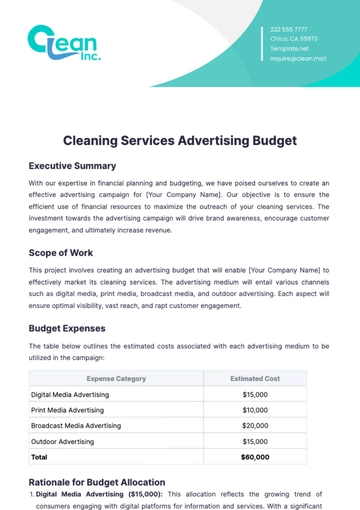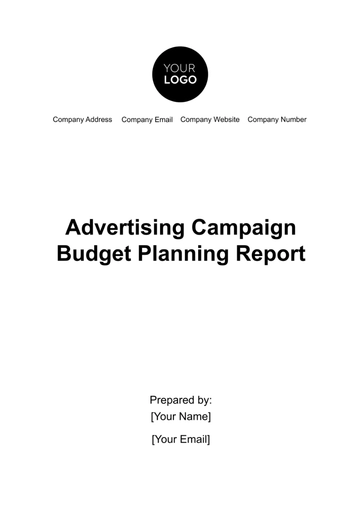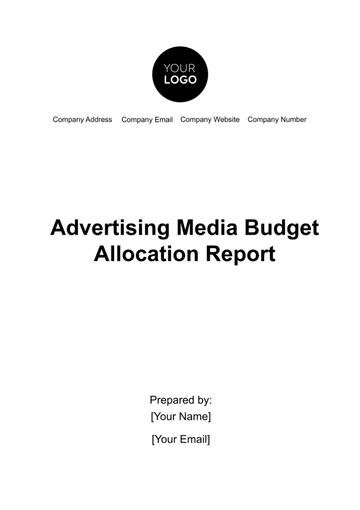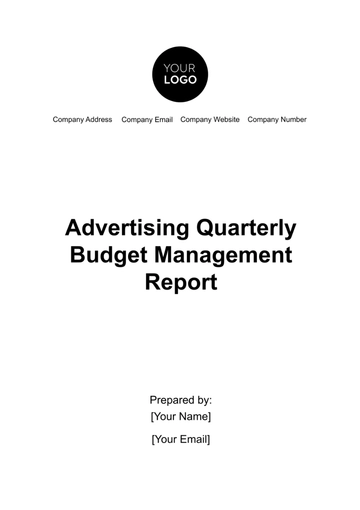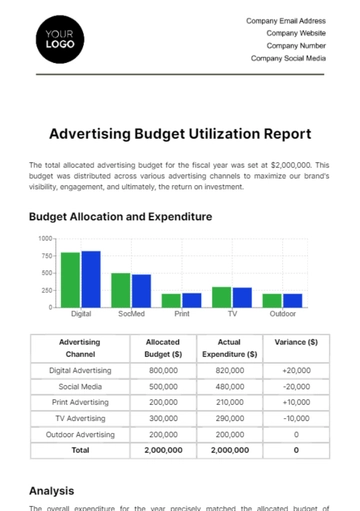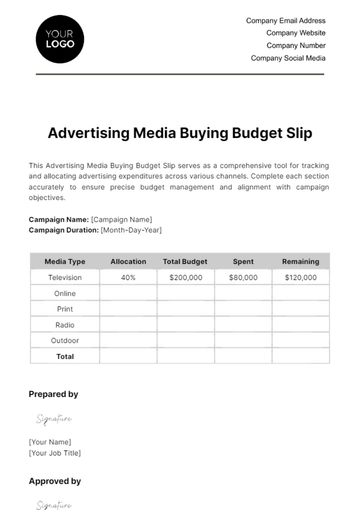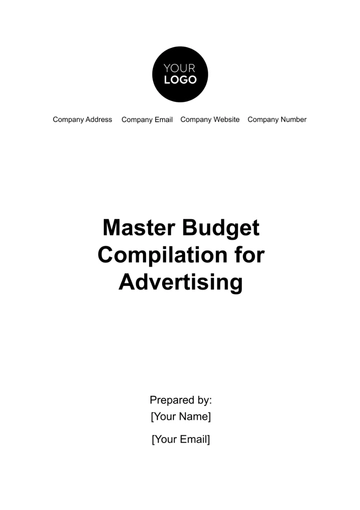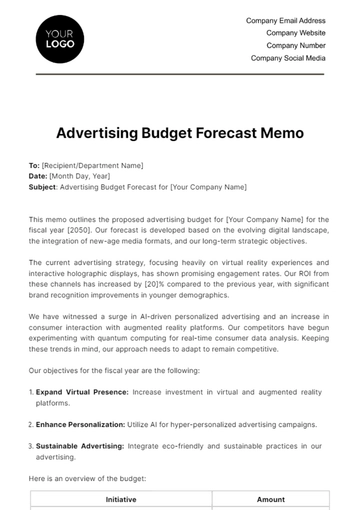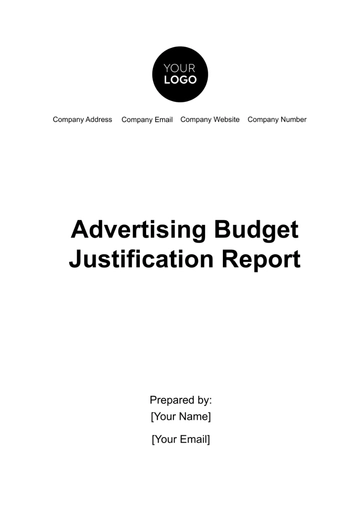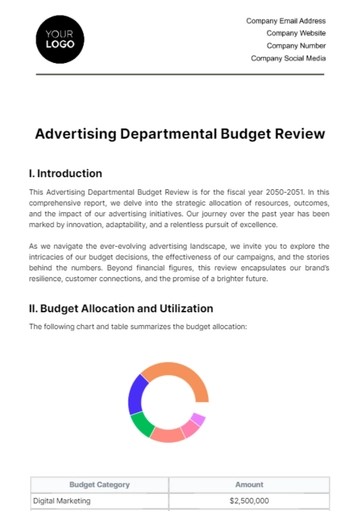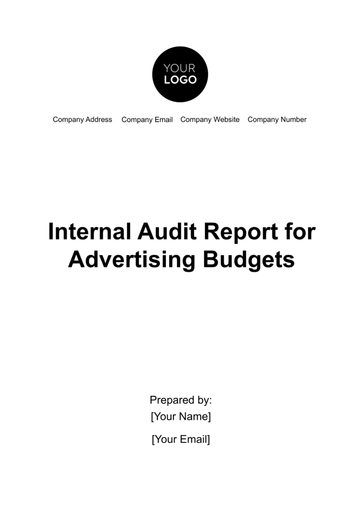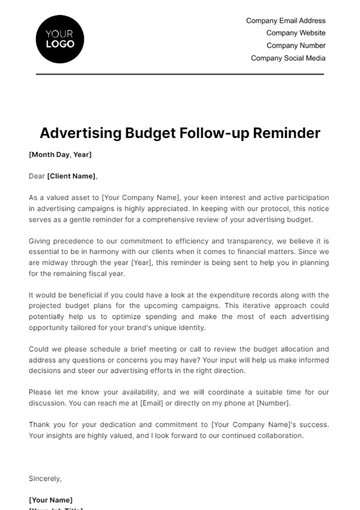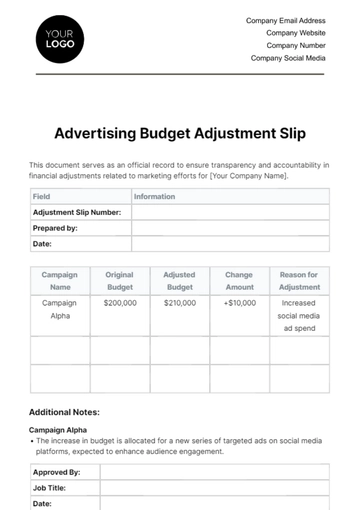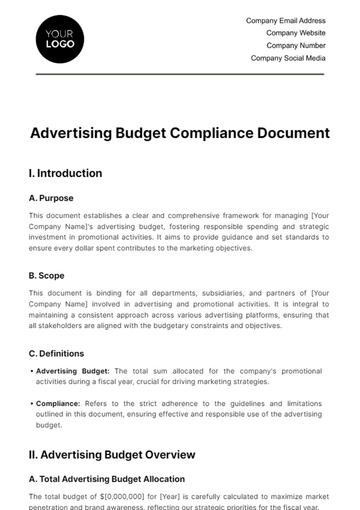Free Advertising Campaign Budget Planning Report
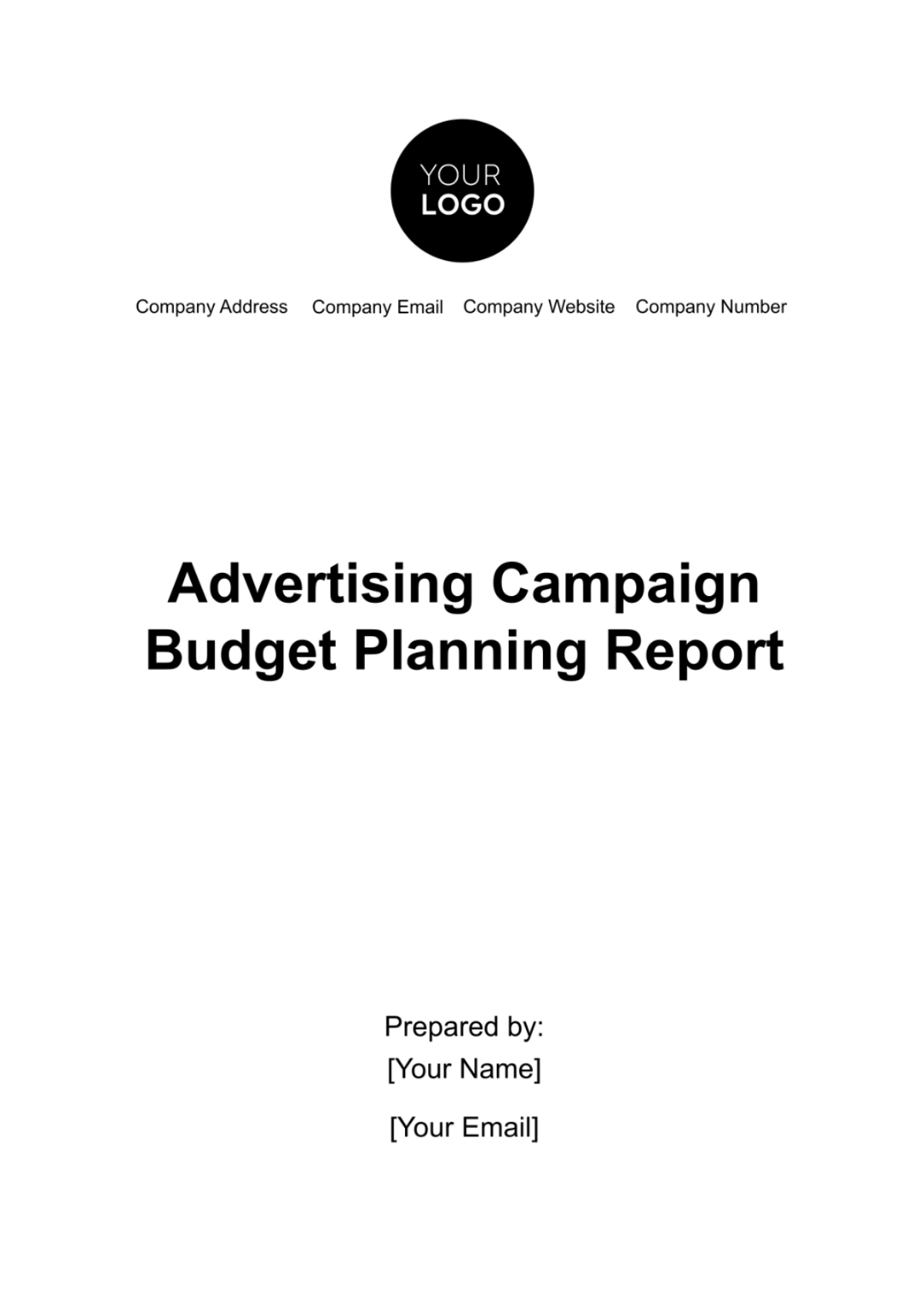
I. Introduction
Campaign budget planning is a critical component of advertising strategy. It involves allocating financial resources to different advertising channels and campaigns to maximize return on investment (ROI) while achieving the desired marketing objectives. [Your Company Name] recognizes the significance of budget planning in achieving client success and brand visibility.
II. Executive Summary
This report provides an in-depth analysis of the campaign budget planning for [Your Company Name]. In today's competitive advertising landscape, effective budget planning is crucial for achieving successful marketing campaigns. This report outlines the key considerations and strategies for allocating budgets across various advertising channels.
III. Budget Allocation Strategy
Effective budget allocation is the cornerstone of a successful advertising campaign. The following strategies will guide [Your Company Name] in making informed decisions regarding the distribution of financial resources across various advertising channels:
Initial Assessment
Before diving into budget allocation, we will embark on a comprehensive client-centric journey. This involves a deep dive into the specific needs, goals, and market dynamics of each client. By conducting in-depth market research and competitor analysis, we will ascertain the unique challenges and opportunities in the client's industry. This meticulous assessment will serve as the bedrock for determining the appropriate budget size that aligns perfectly with the client's objectives.
Channel Allocation
The choice of advertising channels can significantly impact the success of a campaign. Our company will adopt a data-driven approach to allocate budgets across various channels, including digital, print, television, radio, and social media. The allocation will be guided by an extensive understanding of the client's target audience. By analyzing historical data and market trends, we will determine the most effective channels for reaching and engaging with the intended audience. Below illustrates our commitment to precision in channel allocation:
This pie chart shows the percentage for the budget allocation.
Advertising Channel | Estimated ROI |
Digital | 150% |
80% | |
Television | 120% |
Radio | 70% |
Social Media | 180% |
Analysis:
Digital Advertising: Digital channels demonstrate promise with an estimated ROI of 150%. This allocation reflects the growing importance of online platforms in reaching a diverse and digitally savvy audience. The potential for targeted advertising and real-time analytics in the digital realm makes it a priority for budget allocation.
Print Media: Despite the digital era, print media maintains a significant presence in certain markets, hence the 15% allocation. While the estimated ROI of 80% may not be as high as some digital channels, it remains a valuable platform for reaching specific demographics and conveying detailed information.
Television Advertising: Television advertising continues to offer broad reach and impact, making it a substantial portion of the budget at 25%. With an estimated ROI of 120%, it presents an attractive opportunity to engage with a mass audience and build brand recognition.
Radio Advertising: Radio advertising, allocated 10% of the budget, is effective in reaching specific demographics, particularly during commutes and other daily routines. The estimated ROI of 70% indicates its continued relevance in certain markets.
Social Media: Social media campaigns exhibit strong engagement potential, and thus, 10% of the budget is allocated to this channel. With an estimated ROI of 180%, it represents a high-impact and cost-effective way to connect with a wide range of audiences, especially younger demographics.
The allocation percentages are flexible and subject to adjustment based on campaign objectives and performance monitoring. Regular analysis of campaign data will enable [Your Company Name] to fine-tune budget allocation to optimize ROI and meet client goals.
Campaign-Specific Budgeting:
We recognize that one size does not fit all. To maximize the impact of each campaign, we will further break down the budget into specific initiatives. This granular approach will take into account variables such as seasonality, product launches, and special promotions. By tailoring the budget to the unique requirements of each campaign, we ensure that resources are utilized with maximum efficiency to meet specific campaign objectives.
Our budget allocation strategy is rooted in thorough research, data-driven insights, and a commitment to customization. By adhering to these principles, [Your Company Name] aims to provide clients with a roadmap to success in the ever-evolving world of advertising.
IV. Data-Driven Decision-Making
In the ever-evolving landscape of advertising, the ability to make informed decisions based on real-time data is paramount. Our company places a strong emphasis on data-driven decision-making to ensure that campaign budgets are optimized for maximum impact.
Advanced Analytics Tools:
To monitor campaign performance in real-time and extract actionable insights, the company will leverage cutting-edge analytics tools and platforms. These tools will enable us to collect, process, and visualize data from various advertising channels. By employing predictive analytics, we can anticipate trends and make proactive adjustments to campaign strategies.
Key Performance Indicators (KPIs):
We will establish a comprehensive set of Key Performance Indicators (KPIs) tailored to each campaign's objectives. These KPIs will encompass metrics such as click-through rates, conversion rates, cost per acquisition, and return on investment (ROI). The KPIs will serve as benchmarks against which campaign performance will be measured.
Real-Time Monitoring:
Real-time monitoring of campaign performance will be a core practice. Through continuous data tracking and analysis, we will have the ability to identify trends, spot potential issues, and capitalize on opportunities as they arise. Regular reporting will provide our clients with a transparent view of their campaign's progress.
Performance Optimization:
The data collected will not only serve as a retrospective tool but also as a predictive one. By identifying patterns and correlations, we can proactively optimize campaigns in real-time. For example, if certain ad creatives or keywords are performing exceptionally well, we can allocate additional budget to capitalize on their success. Conversely, if a particular channel or strategy is underperforming, we can make adjustments swiftly to avoid wastage of resources.
A/B Testing:
To fine-tune campaign elements, [Your Company Name] will implement A/B testing across various components, including ad copy, visuals, landing pages, and targeting parameters. These tests will provide actionable data on what resonates most effectively with the target audience, enabling us to refine strategies and enhance campaign performance.
Data-driven decision-making is not just a buzzword but a fundamental practice. By harnessing the power of advanced analytics tools, establishing meaningful KPIs, and implementing real-time monitoring and optimization, we ensure that campaign budgets are allocated efficiently, and client objectives are met with precision.
V. Return on Investment Tracking
Measuring the effectiveness of budget allocation is a critical aspect of our campaign strategy. The ability to demonstrate a tangible return on investment is not only essential for our clients but also for refining our advertising strategies.
Comprehensive ROI Metrics:
[Your Company Name] will utilize a comprehensive set of ROI metrics to evaluate campaign performance. These metrics will include:
Conversion Rate: This metric serves as the litmus test for our campaigns. We will diligently track the percentage of users who take a desired action, such as making a purchase, signing up for a newsletter, or filling out a contact form. A high conversion rate signifies that our advertising efforts are not only attracting attention but also compelling users to take meaningful actions, translating into tangible results.
Cost per Acquisition (CPA): Understanding the cost of acquiring each new customer or lead is paramount. By dissecting the expenses associated with each conversion, we gain valuable insights into the efficiency of our campaigns. A low CPA indicates that we are acquiring customers or leads cost-effectively, making it a pivotal metric in optimizing budget allocation.
Customer Lifetime Value (CLV): The true value of a customer extends beyond the initial transaction. CLV analysis delves into the long-term value that customers generated through our advertising efforts bring to the business. By assessing their purchasing behavior, retention rates, and potential for repeat business, we can identify high-value segments and tailor our campaigns to maximize their impact.
Attribution Modeling: We employ sophisticated attribution models to accurately attribute conversions to the appropriate touchpoints along this journey. This provides us with a granular understanding of which channels and interactions are most influential in driving conversions. Armed with this knowledge, we can optimize our budget allocation to prioritize the most effective channels and strategies, ensuring that our campaigns reach their full potential.
Customized ROI Dashboards:
To make ROI tracking more accessible and insightful for our clients, we will develop customized ROI dashboards. These dashboards will provide real-time access to key performance indicators, allowing clients to monitor their campaign's financial performance at a glance. This transparency enhances our client relationships and facilitates collaborative decision-making.
Benchmarking and Comparative Analysis:
We understand the significance of benchmarking. By comparing campaign ROI to industry standards and historical data, we can provide clients with a clear picture of how their advertising efforts stack up against the competition. This information allows us to make strategic adjustments to optimize ROI.
Continuous Improvement:
ROI tracking is not a one-time activity but an ongoing process. We will conduct regular performance reviews and post-campaign analysis to identify areas for improvement. These insights will feed directly into future budget planning, ensuring that each campaign is more effective than the last.
Client Collaboration:
Client involvement is essential in the ROI tracking process. Regular meetings and discussions will take place to review ROI metrics, align campaign goals with actual performance, and make informed decisions about budget reallocation or optimization.
ROI tracking is at the heart of our commitment to delivering value to our clients. By employing a robust set of metrics, custom dashboards, benchmarking, continuous improvement, and collaborative client engagement.
VI. Risk Mitigation and Contingency Planning
While careful budget planning is essential, the advertising landscape is not without its uncertainties. In this section, we will outline our approach to risk mitigation and contingency planning to ensure that our campaigns remain flexible and resilient.
Identifying Potential Risks:
Before embarking on any campaign, our company will conduct a thorough risk assessment. This involves identifying potential challenges and uncertainties that could impact the campaign's performance. Risks may include sudden market shifts, unexpected competitor actions, changes in consumer behavior, or external events such as economic downturns or public health crises.
Risk Analysis and Prioritization:
Once potential risks are identified, we will analyze and prioritize them based on their potential impact and likelihood. This allows us to focus our attention on the most critical risks that could significantly affect the campaign's success.
Contingency Planning:
For each high-priority risk, [Your Company Name] will develop a contingency plan. Contingency plans outline predefined actions and strategies to mitigate the impact of these risks should they materialize. These plans will include alternative budget allocation scenarios, messaging adjustments, and tactical shifts to adapt to changing circumstances.
Monitoring and Adaptive Strategy:
Our approach to risk mitigation does not end with the development of contingency plans. Throughout the campaign, we will actively monitor key performance indicators and market dynamics. This real-time monitoring allows us to detect potential issues early and trigger contingency plans when necessary. It also provides us with the agility to adapt and adjust campaign strategies on the fly.
Client Communication:
Transparency and open communication are paramount in risk mitigation. In the event that a significant risk materializes, we are committed to promptly informing our clients. We will discuss the situation candidly, present our contingency plans, and collaborate with clients to make informed decisions about budget reallocation or strategy adjustments.
Risk mitigation and contingency planning are integral components of our campaign budget planning process. They ensure that we remain prepared to navigate unforeseen challenges and uncertainties, safeguarding the success of our campaigns and the interests of our valued clients.
VII. Conclusion
Effective campaign budget planning is essential for the success of advertising campaigns. By conducting thorough assessments, allocating budgets strategically, and employing data-driven decision-making, [Your Company Name] aims to provide clients with the best possible return on their advertising investments. This report outlines the fundamental strategies that the company will employ in campaign budget planning, ensuring that resources are used efficiently to achieve clients' marketing goals.
Going forward, it is crucial to review this plan continually, adapt to the market's dynamic conditions, and make necessary changes to ensure our brand's successful presence in the competitive market.
- 100% Customizable, free editor
- Access 1 Million+ Templates, photo’s & graphics
- Download or share as a template
- Click and replace photos, graphics, text, backgrounds
- Resize, crop, AI write & more
- Access advanced editor
Utilize Template.net's Advertising Campaign Budget Planning Report template to effectively manage your marketing finances. Fully customizable and editable in our Ai Editor Tool, this template assists in capturing key financial data for profound decision-making. Driven by precision, it reinforces efficient budget control for successful campaigns. Experience a seamless, clear-cut approach to advertising budget planning today!
You may also like
- Budget Sheet
- Personal Budget
- Non Profit Budget
- Monthly Budget
- Project Budget
- HR Budget
- Company Budget
- Home Budget
- Weekly Budget
- College Budget
- Business Budget
- Construction Budget
- Small Business Budget
- Hotel Budget
- Annual Budget
- Home Renovation Budget
- Household Budget
- Student Budget
- Grocery Budget
- Marketing Budget
- Corporate Budget
- Startup Budget
- Manufacturing Budget
- Church Budget
- University Budget
- Annual Budget Plan
- Event Budget
- Operating Budget
- Travel Budget
- Food Budget
- IT and Software Budget
- School Budget
- Real Estate Budget
- Sales Budget
- Conference Budget
- Budget Finance
- Freelancer Budget
- Budget Advertising
